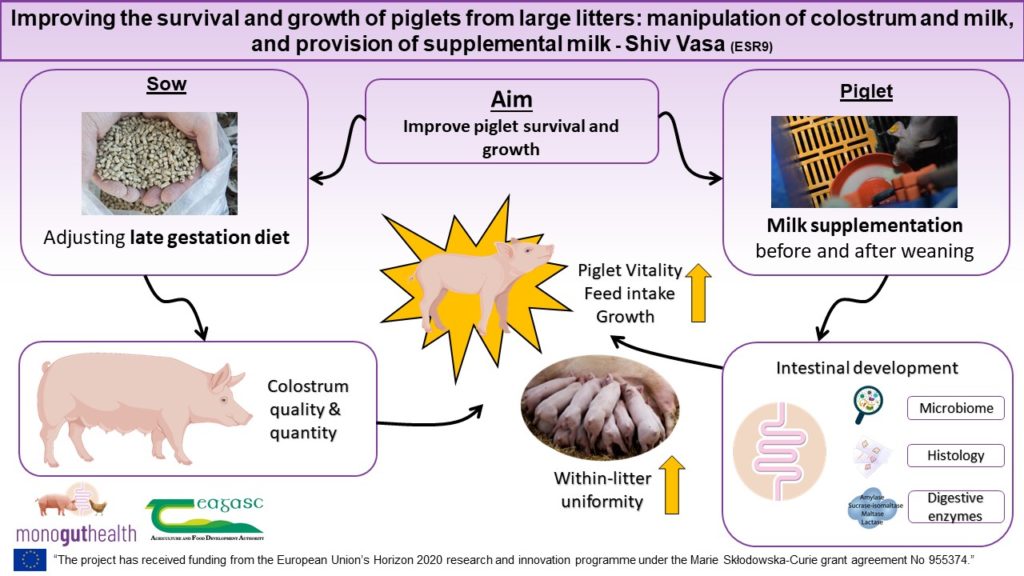ESR9: Improving the survival and growth of piglets from large litters: manipulation of colostrum and milk, and provision of supplemental milk
Background
Increased litter size in sows is linked with decreased piglet birth weight (BtW) and reduced neonatalRelating to newborn individual. survival. The number of underdeveloped piglets born to these large litters is increased, resulting in some piglets showing signs of Intra-Uterine Growth Restriction (IUGRIntra-uterine growth retardation, is defined as the impaired growth of the fetus or its organs durin…). Low BtWPiglets weighing between 0.8 and 1.2 kg. and particularly IUGRIntra-uterine growth retardation, is defined as the impaired growth of the fetus or its organs durin… piglets have reduced vitality at birth and are more prone to morbidity and early postnatal mortality. The objective of this project is to identify and evaluate nutritional strategies for pregnant sows and piglets that improve pre- and post-weaningPeriod after the piglets are separated (weaned) from the sows. survival, growth and intestinal development. Strategies to be assessed will include; (1) nutritional interventions (e.g. probioticsLive microbial feed supplements, which beneficially affects the host animal by improving its intesti…, prebioticsSelectively fermented ingredients that allows specific changes in the composition or activity of the…, and other feed additivesProducts used in animal nutrition to achieve an effect on the feed itself, on the animals, on food p…) in sows during late gestationA period of time between conception and birth. During this time, the fetuses (unborn piglets) grow a… and lactation to improve colostrumThe first form of milk produced by sows immediately following birth of piglets. Colostrum has an esp…/milk yield and quality and; (2) the automatic provision of supplementary milk and/or liquid feed to suckling and newly weaned piglets.
Objectives
Identify and evaluate nutritional strategies for pregnant sows and piglets that improve post-natal survival, growth and GITThe part of the digestive system that consists of the stomach and intestines. development.
Improve colostrumThe first form of milk produced by sows immediately following birth of piglets. Colostrum has an esp... yield and quality.
Improve post-weaningPeriod after the piglets are separated (weaned) from the sows. growth and GITThe part of the digestive system that consists of the stomach and intestines. development.
Methods
Monitoring growth, feed intake, feed conversion efficiency, mortality, diarrhoea incidence and antibiotic use from birth to slaughter.
Assess colostrumThe first form of milk produced by sows immediately following birth of piglets. Colostrum has an esp... quality and quantity produced, gut microbiomeCollective genetic material of the microbes (for example bacteria, fungi and viruses) that live insi... composition, enzyme gene expressionA process by which information from a gene is used for protein synthesis. Ultimately this whole proc... and intestinal histologyA branch of biology which studies the microscopic anatomy of biological tissues. .
With piglet nutritional strategies, identify eaters and non-eaters within each group using observation of feeding behaviour and by adding an inert colour marker to the feed and visually inspecting the colour of rectal swabs.
Expected results
Piglet BtW, vitality, within litter uniformity in piglet BtW and pre- and post-weaningPeriod after the piglets are separated (weaned) from the sows. growth will be improved with both strategies.
Sow nutritional interventions will alter the sow and piglet microbiomeThe diverse consortium of bacteria, archaea, fungi, protozoa, viruses, and their collective genome f... and improve the growth and development of the maternal mammary gland leading to enhanced piglet vitality, colostrumThe first form of milk produced by sows immediately following birth of piglets. Colostrum has an esp... yield and quality (D2.12).
Provision of supplemental milkExtra milk (commonly dairy milk is used) provided to support piglets, especially when the sow is not... and/or liquid feed to suckling and newly weaned piglets from large litters will improve piglet survival, health and growth to target slaughter weight (D1.5).
Planned secondments
- At: Kiernan Milling (1 mo); Experience in milk replacer formulation for piglets;
- At: WBF-A (3 mo); Test sow nutritional strategy with different conditions (different breed, different management conditions and/or ETEC challenge)
Enrolment in Doctoral degree:
ESR9 will be enrolled at the at the School of Science, Waterford Institute of Technology.
Supervisors
Peadar Lawlor (TEAGASC), Giuseppe Bee (Agroscope), Keelin O’Driscoll (TEAGASC), Gillian Gardiner (WIT)
